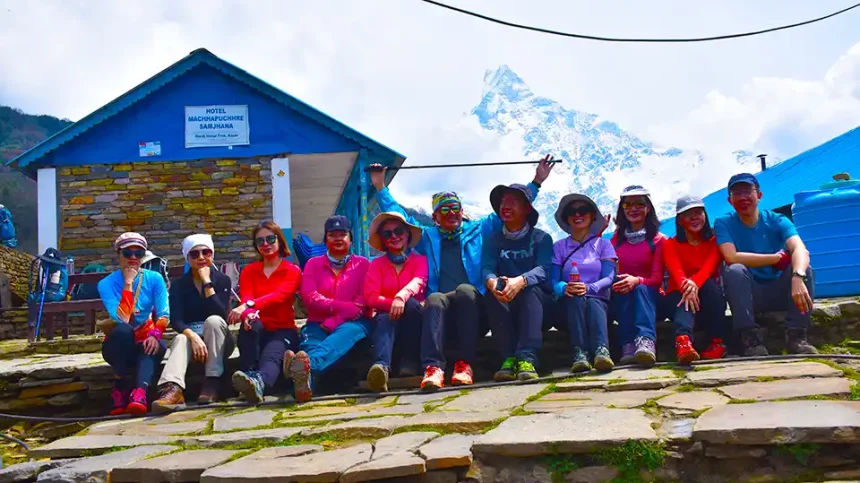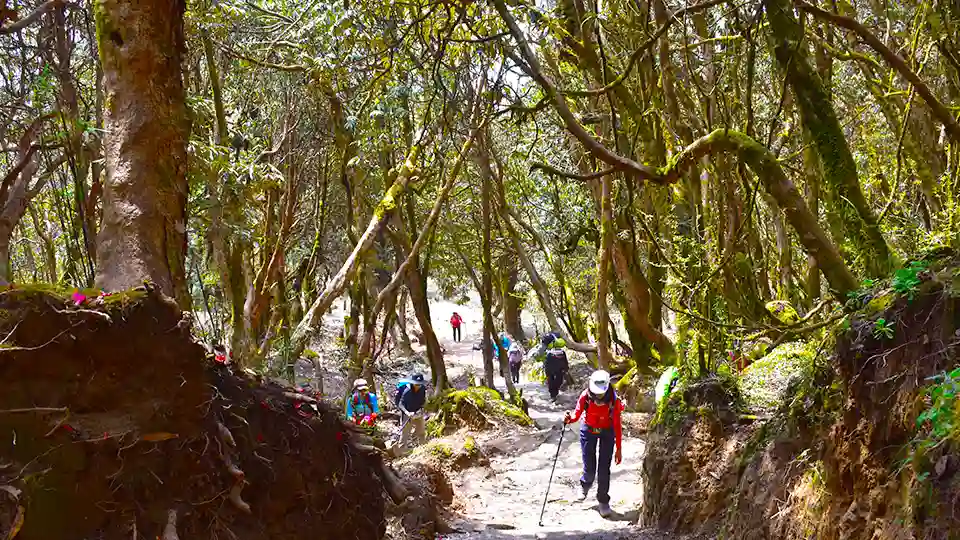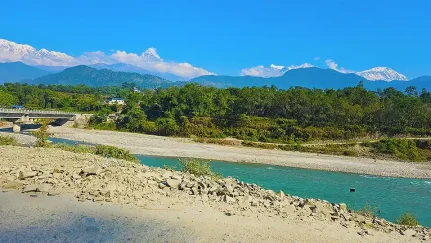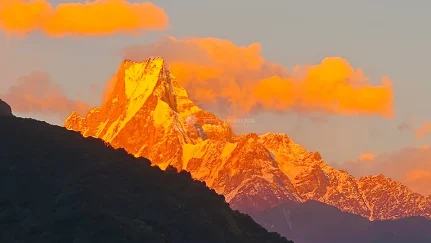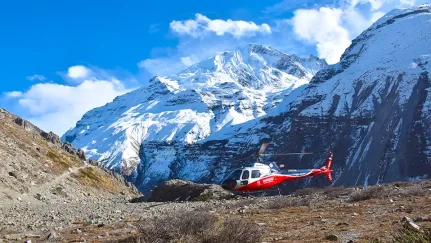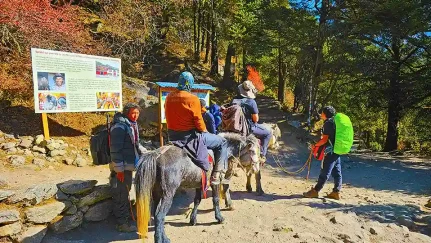Mardi Himal Low Camp is a key stop on the Mardi Himal Trek. It’s a popular place for trekkers to rest and get used to the higher altitude. Located in the Annapurna region, Low Camp offers a mix of natural beauty, local culture, and basic facilities, making it a special part of the trek.
Low Camp sits at about 2,990 meters (9,810 feet) above sea level. When you reach this point, you’ll notice a change in the landscape—from thick rhododendron forests at Forest Camp to more open, rocky areas. This change is not just beautiful but also important for helping your body adjust to the altitude.
The people who live at Low Camp are mostly from the Gurung and Magar communities. They offer a peek into their traditional way of life. The simple lodges and teahouses provide a cozy place for trekkers to rest before continuing to High Camp and Mardi Himal Base Camp.
The trek from Forest Camp to Low Camp is moderately challenging with some steep climbs. The trail is well-marked, and you’ll enjoy amazing views of the Annapurna Massif and Machapuchare (Fishtail) Mountain along the way.
Whether you’re here to enjoy the peaceful Himalayas, learn about local culture, or prepare for the tougher parts of the trek, Mardi Himal Low Camp is a must-visit, offering both rest and inspiration on your journey.
What is Mardi Himal Low Camp?
Mardi Himal Low Camp is an important stop on the Mardi Himal Trek, a lesser-known but increasingly popular route in the Annapurna region of Nepal. Located at about 2,990 meters (9,810 feet), Low Camp is a key place for trekkers to take a break and get used to the higher altitude.
Surrounded by beautiful rhododendron and oak forests, Low Camp offers stunning views of the Annapurna South, Hiunchuli, and Machapuchare (Fishtail) mountains. It’s a favorite spot for trekkers to pause and enjoy the natural beauty of the Himalayas.
As you reach Low Camp, you’ll notice a change from the green forests below to a more rugged landscape with fewer trees. This change not only looks cool but also shows that the trek is getting harder. Low Camp is the perfect place to rest, get used to the altitude, and prepare for the challenges ahead.
Besides being a practical stop, Low Camp offers a unique cultural experience. The lodges and teahouses are often run by local Gurung and Magar families. This gives trekkers a chance to connect with the local culture and enjoy their warm hospitality. The simple life at Low Camp, combined with the amazing surroundings, creates a peaceful atmosphere that many trekkers love.
Location and Altitude of Low Camp
Mardi Himal Low Camp is located in the Annapurna Conservation Area, one of the most protected and biodiverse regions in Nepal. It sits along the Mardi Himal trekking route at about 2,990 meters (9,810 feet) above sea level. This height is important for trekkers because it marks the move from lower to higher altitudes, where the air gets thinner and the trek becomes more challenging.
Low Camp is a natural resting point between Forest Camp and High Camp, the next big stop on the trail. Its altitude helps trekkers get used to the higher elevation, reducing the risk of altitude sickness. The camp also offers breathtaking views of the Himalayan peaks, making it a highlight of the trek.
The mix of its height, location, and cultural charm makes Mardi Himal Low Camp an essential part of the trekking experience, offering practical benefits and unforgettable moments in the heart of the Himalayas.
Cultural Insights: Village Life at Mardi Himal Low Camp
Mardi Himal Low Camp is not just about amazing landscapes and tough trails; it’s also a place where you can learn about the rich culture of the Himalayan region. The village at Low Camp is small and close-knit, where old traditions are still alive. The people living here are mostly from the Gurung and Magar ethnic groups, who have deep connections to the land.
Life in the village is simple and revolves around traditional practices passed down through generations. The villagers’ daily lives are closely tied to nature, with farming and taking care of animals being their main jobs. Visitors often find themselves enjoying the slow, peaceful pace of life that is very different from the busy city.
The cultural experience at Low Camp is made even better by the friendliness of the locals. Staying at a local teahouse or lodge lets you interact with the villagers, learn about their customs, and maybe even join in on some traditional activities, like cooking together or celebrating local festivals.
Major Ethnicity and Religion
The main ethnic groups at Low Camp are the Gurung and Magar communities. Both have strong roots in the Annapurna region and are known for their unique cultural traditions. The Gurungs are especially famous for their role as Gurkha soldiers, known for their bravery. They also have a rich cultural heritage, including traditional music, dance, and rituals that are important to their way of life.
Religion is very important to the people at Low Camp. Most of them practice a mix of Hinduism and Buddhism, with some beliefs in nature spirits as well. These religious practices are a big part of daily life, and you might see prayer flags, shrines, and locals praying or performing rituals during your visit.
Buddhism is the main religion at Low Camp, and you’ll see many chortens (stupas), prayer wheels, and mani walls (stone walls with sacred texts) along the trekking route. These religious symbols are not only spiritual markers but also show the strong connection between the local people and their faith. The villagers often take part in religious ceremonies and festivals, which bring the community together and celebrate their cultural identity.
Oxygen Concentration at Low Camp
As you climb to higher altitudes, the oxygen in the air decreases, which can be tough for those not used to it. At Mardi Himal Low Camp, which is about 2,990 meters (9,810 feet) high, the oxygen level is lower than at sea level. The oxygen concentration here is about 70% of what you’d find at lower altitudes.
This drop in oxygen can cause altitude sickness, with symptoms like headaches, nausea, and feeling short of breath, especially if you climb too quickly. Your body needs time to adjust to the thinner air, which is why Low Camp is an important place to stop and acclimatize on the Mardi Himal Trek. Spending time here helps your body get used to the lower oxygen before you climb higher.
While at Low Camp, it’s important to keep an eye on your health and take steps to acclimatize properly. This includes drinking lots of water, eating good food, and getting enough rest. The reduced oxygen makes it important to go slow and let your body adjust gradually, which will help reduce the risk of altitude sickness as you continue on your trek.
How to Get to Mardi Himal Low Camp
Getting to Mardi Himal Low Camp is an amazing adventure through some of the most beautiful places in the Annapurna region. Low Camp is an important stop on the Mardi Himal Trek. The journey there includes trekking on paths that are both challenging and rewarding. Here’s how you can get to Mardi Himal Low Camp, with easy-to-follow instructions to make sure you’re ready for the trip.
Route from Forest Camp to Low Camp
The trek from Forest Camp to Low Camp is one of the most beautiful parts of the Mardi Himal Trek. You’ll walk through thick forests filled with rhododendron trees, especially colorful in the spring when the flowers bloom. The path goes uphill most of the time, with some steep and some easier sections, making it a bit tough but manageable for most trekkers.
Distance and Terrain
The distance from Forest Camp to Low Camp is about 4 kilometers (2.5 miles). Even though it’s not a long distance, it can be tough because you’re climbing uphill and the terrain is different in places. The trail is mostly clear and takes you through lush forests, with some open spots where you can see the mountains around you. The ground can get slippery, especially if it has rained, so it’s important to wear good trekking boots with a strong grip.
Estimated Trekking Time
It usually takes about 3 to 4 hours to trek from Forest Camp to Low Camp, depending on how fast you go and the weather. It’s best to start early in the morning so you don’t get caught in the afternoon mist, which can make it hard to see and walk on the trail. There are a few spots along the way where you can rest, drink water, and enjoy the peaceful forest.
Directions and What to Expect
When you leave Forest Camp, the trail starts with a steep climb through thick rhododendron forests. The path is mostly shaded, keeping you cool as you walk. As you climb higher, the trees start to thin out, and you’ll catch glimpses of the Annapurna and Machapuchare (Fishtail) mountains.
After about an hour of trekking, the path becomes a bit easier before you face another steep climb. This part of the trail is more open, giving you wide views of the valleys and mountains around you. Keep following this trail until you reach a large open area, which is Low Camp.
At Low Camp, you’ll find a few teahouses where you can rest and get something to eat. The camp is on an open ridge, offering stunning views of Machapuchare and other nearby mountains, especially at sunrise and sunset.
It’s a good idea to have a map of the trail from Forest Camp to Low Camp. It will help you find your way and understand the changes in altitude. You can get a trekking map in Pokhara before you start your trek or from one of the teahouses at Forest Camp.
In summary, the trek from Forest Camp to Low Camp is a fantastic experience that brings you closer to the heart of the Himalayas. With its beautiful scenery and the chance to see the mighty peaks up close, this part of the Mardi Himal Trek is sure to be a highlight of your journey.
Accommodation and Facilities at Mardi Himal Low Camp
When you’re planning a trek to Mardi Himal Low Camp, it’s important to know what kind of place you’ll be staying at and what you can expect there. Low Camp has basic but good enough facilities to make sure you have a comfortable stay and are ready for the next part of your journey.
Cost and Price of Teahouses
The teahouses at Mardi Himal Low Camp are simple and no-frills, which is common for trekking lodges in the Himalayas. Most of these teahouses are run by local families, so they feel cozy and welcoming, even though the facilities are basic.
- Room Rates: Staying in a teahouse at Low Camp usually costs between NPR 500 to NPR 800 per night (around USD 4 to 7). The price can go up a little during the busy trekking seasons, like spring and autumn. Rooms are usually for two people, with two single beds, a small table, and sometimes blankets. It’s a good idea to bring your own sleeping bag to stay warm.
- Meal Prices: Meals are not included in the room cost. The price for food at Low Camp ranges from NPR 300 to NPR 700 per meal (about USD 2.50 to 6). You can usually find local Nepali dishes like dal bhat (rice and lentils), as well as other simple foods like noodles, soup, and bread. The higher you go, the more expensive the food gets because it’s harder to get supplies up the mountain.
- Cost of Drinks: Drinks like tea, coffee, and bottled water are also available at the teahouses. A cup of tea or coffee costs around NPR 150 to NPR 300 (about USD 1.25 to 2.50), and a bottle of water can cost NPR 200 to NPR 400 (about USD 1.75 to 3.50), depending on how easy it is to get.
Facilities Available at Low Camp
The facilities at Low Camp are basic but good enough to give you the rest and refreshment you need. Here’s what you can expect:
- WiFi: Some teahouses at Low Camp offer WiFi, but it’s usually slow and you have to pay extra for it. The cost for WiFi can range from NPR 300 to NPR 500 (about USD 2.50 to 4) for a small amount of data. Because you’re in a remote area, the connection might not always work well, so it’s better not to rely on it for important communication.
- Electricity: Most teahouses have electricity for lighting and charging your devices. You might have to pay a small fee, usually around NPR 100 to NPR 300 (about USD 1 to 2.50) per hour to charge your phone or camera. The electricity often comes from solar panels, so it might not always be available, especially on cloudy days.
- Toilets: The toilets at Low Camp are basic and are usually shared. They might be squat-style or Western-style and are often outside the main building. The cleanliness can vary, but the teahouse owners usually try to keep them clean. It’s a good idea to bring your own toilet paper and hand sanitizer because these might not be provided.
- Communication: Mobile phone coverage at Low Camp is limited and might not be reliable. It’s best to tell your family or friends before the trek that you might not be able to contact them for a while. Some trekkers carry a local SIM card with data, but the signal is often weak.
- Basic Amenities: Most teahouses have a dining area where trekkers can eat and relax together. There’s usually a common area with a fireplace or stove to keep warm. Some teahouses might sell basic trekking supplies, snacks, and toiletries, but it’s best to bring what you need from the start.
Showers and Toilet Facilities
- Showers: Showers are available at Low Camp, but they’re pretty basic. Most teahouses offer hot showers heated by gas or solar power. Hot water might be limited, especially when many trekkers want to shower at the same time. A hot shower usually costs between NPR 300 to NPR 500 (about USD 2.50 to 4). The shower facilities are clean enough, but simple, so it’s important to manage your expectations.
- Toilet Facilities: The toilets are shared and might be squat-style or Western-style. They’re usually a short walk from where you sleep. While they work fine, they might not be as comfortable or clean as what you’re used to, so bringing your own hygiene items is a good idea.
Food Options at Low Camp
- Local Cuisine: The food at Low Camp is simple but filling, giving you the energy you need for trekking. Dal bhat, a traditional Nepali meal of rice, lentil soup, vegetables, and sometimes meat, is a popular choice because it’s nutritious and comes in large portions.
- Other Meal Options: Besides dal bhat, you can find other meals like fried rice, noodles, pasta, and soup. Some teahouses might offer Western food like pancakes or omelets for breakfast. Vegetarian options are usually available, but it’s a good idea to let the teahouse know ahead of time if you have any special dietary needs.
- Snacks and Drinks: Teahouses also sell snacks like biscuits, chocolate bars, and packaged noodles, but they cost more than in the lower regions because of transportation costs. You can also find drinks like tea, coffee, hot chocolate, and sometimes soft drinks or beer, though the latter can be expensive.
In summary, while the accommodations and facilities at Mardi Himal Low Camp are basic, they meet the needs of trekkers. The teahouses offer a cozy atmosphere, warm food, and essential services that make your trekking experience more comfortable.
Practical Tips for Staying at Mardi Himal Low Camp
Staying at Mardi Himal Low Camp is an important part of your Mardi Himal Trek. It’s where you can rest and get used to the altitude. To have a good time and make the most of your stay, here are some simple tips on what to pack, how to stay comfortable, and when to visit.
Best Time to Visit and Weather Considerations
Choosing the right time to visit Mardi Himal Low Camp can make your trek easier and more enjoyable. The weather changes with the seasons, which can affect how difficult and comfortable the trek is. Here’s a comparative overview of the different seasons:
| Season | Best Time to Visit | Weather Conditions | Temperature Range | Pros | Cons |
| Spring (March – May) | Ideal | Mild, stable weather with clear skies | 5°C to 15°C (41°F to 59°F) | Excellent visibility, blooming rhododendrons, pleasant temperatures | Can be crowded, moderate risk of avalanches |
| Summer (June – August) | Less Ideal | Monsoon rains with occasional landslides | 10°C to 20°C (50°F to 68°F) | Fewer trekkers, lush landscapes | Heavy rainfall, slippery trails, potential for leeches |
| Autumn (September – November) | Ideal | Clear skies, cool temperatures, and stable weather | 0°C to 10°C (32°F to 50°F) | Great trekking conditions, fewer chances of rain, beautiful scenery | Can be crowded, slightly colder nights |
| Winter (December – February) | Not Ideal | Cold temperatures, occasional snowfall | -10°C to 5°C (14°F to 41°F) | Fewer trekkers, serene environment | Very cold, potential snow-blocked trails, risk of altitude sickness |
Best Time to Visit and Weather Tips
Best Time to Visit:
Spring and Autumn are the best times to go Mardi Himal Low Camp. The weather is stable, and the temperatures are just right for trekking. During these seasons, you’ll get clear views of the Himalayas, and the trek is usually more comfortable.
Weather Tips:
- Spring: In spring, the weather is mild, and you’ll see lots of beautiful blooming flowers along the way, making the trek really pretty.
- Summer: Summer brings heavy rains because of the monsoon. This can make the trails muddy and slippery, which could be dangerous because of the risk of landslides.
- Autumn: Autumn has clear skies and cool temperatures, making it another great time for trekking. But remember, it can get busy with other trekkers.
- Winter: Winter is the coldest time to visit. There’s a chance of snow and ice, making the trek harder and less comfortable.
Health and Safety Tips
Staying healthy and safe is super important when you’re at Mardi Himal Low Camp. Here are some easy tips to help you stay well and safe:
Acclimatization (Getting Used to the Altitude):
- Climb Slowly: To avoid getting sick from the altitude, go up slowly and give your body time to get used to it. Don’t climb more than 500 meters (about 1,640 feet) in one day when you’re above 3,000 meters (about 9,843 feet).
- Drink Lots of Water: Keep yourself hydrated by drinking plenty of water. This helps prevent altitude sickness. Try to drink at least 3-4 liters (about 101-135 ounces) of water every day.
- Rest Well: Make sure you get enough rest and don’t push yourself too hard. If you can, include rest days in your schedule.
Altitude Sickness:
- Watch for Symptoms: Be on the lookout for signs of altitude sickness, like headaches, nausea, dizziness, and feeling really tired. If you feel worse or don’t get better, go down to a lower altitude right away.
- Bring Medicine: You might want to carry medicine for altitude sickness, like Diamox (Acetazolamide). Talk to your doctor before the trek to see if it’s right for you. Remember, medicine can help, but it’s not a replacement for going up slowly.
Health Tips:
- Stay Clean: Keep yourself clean. Bring hand sanitizer and toilet paper because they might not always be available.
- Eat Safely: Be careful with food and water to avoid getting a stomach bug. Drink bottled or treated water, and make sure your food is cooked well.
Be Ready for the Weather:
- Dress in Layers: Wear layers so you can adjust to the changing temperatures. Pack thermal clothes, a waterproof jacket, and warm gloves and hats.
- Check the Weather: Keep an eye on the weather forecast before and during your trek so you’re ready for any sudden changes.
By following these tips, you can have a safer and more comfortable stay at Mardi Himal Low Camp, making your trek even more enjoyable!
Experience Trekking to and Staying at Low Camp
Trekking to Mardi Himal Low Camp is a special adventure that lets you connect deeply with nature. Nestled in the beautiful Annapurna region, Low Camp is more than just a stop—it’s a place where you truly experience the essence of the journey. Here’s a look at what makes this experience so memorable.
Scenic Highlights on the Way to Low Camp
- Amazing Mountain Views: As you walk from Forest Camp to Low Camp, one of the first things you’ll notice is the incredible view of the Mardi Himal range. The trail gradually opens up to show stunning sights of Mardi Himal and the towering peaks of Annapurna and Machapuchare (Fishtail) mountains. These snow-covered mountains, often surrounded by wispy clouds, are a breathtaking sight that fills you with awe.
- Lush Forests and Blooming Flowers: The trail winds through thick forests filled with oak, pine, and rhododendron trees. In spring, these rhododendrons burst into bright colors of red, pink, and white, creating a beautiful canopy above you. The sweet smell of the flowers and the gentle rustling of leaves underfoot make the trek even more enjoyable. You might also spot various birds and wildlife, adding to the magic of the forest.
- Rolling Hills and Green Meadows: As you climb higher, the trail leads through rolling hills and open meadows with wide views of valleys and peaks. The gradual ascent lets you see the contrast between the green lower areas and the rugged, rocky terrain higher up. You’ll see grazing yaks and traditional stone huts, making you feel like you’re truly in the heart of nature.
- Peaceful Atmosphere at Low Camp: When you arrive at Low Camp, you’re welcomed by a peaceful and calm environment. The camp sits on a ridge with wide views of the surrounding mountains and valleys. The crisp mountain air and stunning scenery create a feeling of tranquility and accomplishment. The small, cozy teahouses at Low Camp are warm and inviting, offering the perfect spot to relax after a long day of trekking.
- Cultural Encounters: Along the way, you might meet local villagers who warmly greet trekkers. They may invite you for a cup of tea and share stories about their daily lives. These cultural interactions add a rich and personal touch to your trek, making the experience even more meaningful.
- Overall Experience: Trekking to and staying at Mardi Himal Low Camp is not just about the physical challenge; it’s a chance to deeply connect with nature and experience the unique beauty of the region. The trek offers a mix of challenging climbs, rewarding views, and peaceful moments of reflection. The natural beauty and the serene atmosphere at Low Camp leave trekkers with a lasting sense of achievement and unforgettable memories of their Himalayan adventure.
Essential Packing List for Low Camp Mardi Himal
When preparing for your trek to Mardi Himal Low Camp, packing the right items is crucial to ensure comfort and safety. Here’s a simple guide on what to bring:
Clothing and Gear:
Wear Layers: Start with moisture-wicking base layers to keep sweat away from your skin. Add a fleece or softshell jacket for warmth, and bring a down or synthetic jacket for the colder temperatures at Low Camp. For the outer layer, pack a waterproof and windproof jacket and waterproof pants to protect you from rain and wind. Sturdy, waterproof hiking boots are a must, along with comfortable trekking shoes for the trail and camp. Don’t forget to pack warm hats, gloves, and UV-protective sunglasses. Also, bring lightweight, adjustable trekking poles and a warm sleeping bag rated for very cold temperatures.
Comfort and Convenience:
- Power for Electronics: A portable charger or power bank will keep your devices powered since charging options might be limited.
- Personal Care: Pack travel-sized toiletries, a quick-drying towel, and snacks like nuts, dried fruits, and granola bars to keep your energy up.
- Health Kit: Bring a basic first aid kit with band-aids, antiseptic wipes, and any personal medications you need.
- Stay Hydrated: Carry a reusable water bottle or hydration system to drink plenty of water.
- Entertainment: Consider bringing a book or journal for relaxing in your downtime.
- Sun Protection: Pack sunscreen with high SPF and a moisturizing lip balm.
- Trash Bags: Bring bags to carry out all your waste and help keep the environment clean.
By packing these essentials, you’ll be well-prepared for a comfortable and enjoyable trek to Mardi Himal Low Camp.
Conclusion
This guide has covered everything you need to know about trekking to Mardi Himal Low Camp, from understanding its importance as a resting and acclimatization point to navigating the scenic route from Forest Camp. We’ve also explored the rich cultural experiences, the natural beauty, and the health and safety tips to ensure your journey is successful.
Experiencing the peace and beauty of Low Camp is a highlight of the Mardi Himal Trek. Whether you’re drawn by the adventure, the culture, or the stunning views of the Himalayas, Mardi Himal Low Camp promises an unforgettable experience.
As you plan your trek, remember that preparation is key to having a smooth and enjoyable journey. If you have any more questions or need additional information, feel free to reach out. Share this guide with your fellow trekkers, and embark on your adventure with confidence. Let the majestic landscapes and cultural richness of Mardi Himal Low Camp inspire you.

